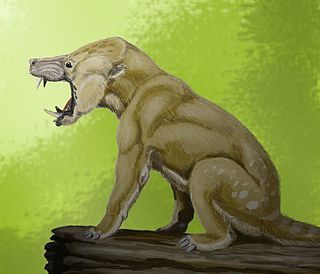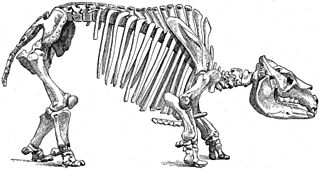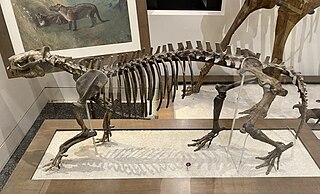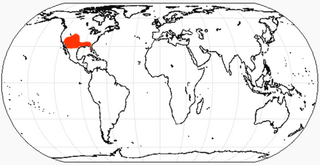
Ungulates are members of the diverse clade Euungulata, which primarily consists of large mammals with hooves. Once part of the clade "Ungulata" along with the clade Paenungulata, "Ungulata" has since been determined to be a polyphyletic and thereby invalid clade based on molecular data. As a result, true ungulates had since been reclassified to the newer clade Euungulata in 2001 within the clade Laurasiatheria while Paenungulata has been reclassified to a distant clade Afrotheria. Living ungulates are divided into two orders: Perissodactyla including equines, rhinoceroses, and tapirs; and Artiodactyla including cattle, antelope, pigs, giraffes, camels, sheep, deer, and hippopotamuses, among others. Cetaceans such as whales, dolphins, and porpoises are also classified as artiodactyls, although they do not have hooves. Most terrestrial ungulates use the hoofed tips of their toes to support their body weight while standing or moving. Two other orders of ungulates, Notoungulata and Litopterna, both native to South America, became extinct at the end of the Pleistocene, around 12,000 years ago.

Condylarthra is an informal group – previously considered an order – of extinct placental mammals, known primarily from the Paleocene and Eocene epochs. They are considered early, primitive ungulates. It is now largely considered to be a wastebasket taxon, having served as a dumping ground for classifying ungulates which had not been clearly established as part of either Perissodactyla or Artiodactyla, being composed thus of several unrelated lineages.

Notoungulata is an extinct order of ungulates that inhabited South America from the early Paleocene to the end of the Pleistocene, living from approximately 61 million to 11,000 years ago. Notoungulates were morphologically diverse, with forms resembling animals as disparate as rabbits and rhinoceroses. Notoungulata are the largest group of South American native ungulates, with over 150 genera in 14 families having been described, divided into two major subgroupings, Typotheria and Toxodontia. Notoungulates first diversified during the Eocene. Their diversity declined from the late Neogene onwards, with only the large toxodontids persisting until the end of the Pleistocene, perishing as part of the Late Pleistocene megafauna extinctions along with most other large mammals across the Americas. Collagen sequence analysis suggests that notoungulates are closely related to litopterns, another group of South American ungulates, and their closest living relatives being perissodactyls, including rhinoceroses, tapirs and equines as part of the clade Panperissodactyla. However their relationships to other South American ungulates are uncertain. Several groups of notoungulates separately evolved ever-growing cheek teeth.

Phenacodus is an extinct genus of mammals from the late Paleocene through middle Eocene, about 55 million years ago. It is one of the earliest and most primitive of the ungulates, typifying the family Phenacodontidae and the order Perissodactyla.

Macrauchenia is an extinct genus of large ungulate native to South America from the late Pliocene to the end of the Pleistocene. It is a member of the extinct order Litopterna, a group of South American native ungulates distinct from the two orders which contain all living ungulates which had been present in South America since the early Cenozoic, over 60 million years ago, prior to the arrival of living ungulates in South America around 2.5 million years ago as part of the Great American Interchange. The bodyform of Macrauchenia has been described as similar to a camel, being one of the largest known litopterns, with an estimated body mass of around 1 tonne. The genus gives its name to its family, Macraucheniidae, which like Macrauchenia typically had long necks and three toed feet, as well a retracted nasal region, which in Macrauchenia manifests as the nasal opening being on the top of the skull behind the eye sockets. This has historically been argued to correspond to the presence of a tapir-like proboscis, but some recent authors suggest a moose-like prehensile lip or a saiga antelope-like nose to filter dust are more likely.

Miacidae is a former paraphyletic family of extinct primitive placental mammals that lived in North America, Europe and Asia during the Paleocene and Eocene epochs, about 65–33.9 million years ago. These mammals were basal to order Carnivora, the crown-group within the Carnivoraformes.

Arctocyon is an extinct genus of ungulate mammals. Arctocyon was a "ground dwelling omnivore", that lived from 61.3-56.8 Ma. Synonyms of Arctocyon include Claenodon, and Neoclaenodon. Arctocyon was likely plantigrade, meaning that it walked with its feet flat on the ground, rather than on its toes.
Victorlemoinea is an extinct litoptern genus of the family Sparnotheriodontidae, that lived from the Early to Middle Eocene. Fossils of Victorlemoinea have been found in the Las Flores, Sarmiento and Koluel Kaike Formations of Argentina, the Itaboraí Formation of Brazil and La Meseta Formation, Antarctica.

Kolponomos is an extinct genus of carnivoran mammal that existed in the Late Arikareean North American Land Mammal Age, early Miocene epoch, about 20 million years ago. It was likely a marine mammal. The genus was erected in 1960 by Ruben A. Stirton, a paleontologist at the University of California Museum of Paleontology, Berkeley, for the species K. clallamensis, on the basis of a partial skull and jaw found on the Olympic Peninsula. At the time, Stirton questionably assigned it to Procyonidae, its systematic position remained problematic until the discovery of more fossils including a nearly complete cranium from the original locality of K. clallamensis which helped identify it as part of the group from which pinnipeds evolved.

Toxodontidae is an extinct family of notoungulate mammals, known from the Oligocene to the Holocene of South America, with one genus, Mixotoxodon, also known from the Pleistocene of Central America and southern North America. Member of the family were medium to large-sized, ranging from around 350–400 kilograms (770–880 lb) in Nesodon to 1,000–1,200 kilograms (2,200–2,600 lb) in Toxodon, and had medium to high-crowned dentition, which in derived members of the group evolved into ever-growing cheek teeth. Isotopic analyses have led to the conclusion that Pleistocene members of the family were flexible mixed feeders.

The giant tapir is an extinct species of tapir that lived in southern China, Vietnam and Laos, with reports suggesting it also lived in Taiwan, Java, and potentially Borneo. The species has been recorded from Middle and Late Pleistocene. There is only weak evidence for a Holocene survival. Tapirus augustus was larger than any living tapir, with an estimated weight of about 623 kilograms (1,373 lb). The species was also placed in its own genus of Megatapirus, however, it is now conventionally placed within Tapirus.

Carpocyon is an extinct genus of the Borophaginae subfamily of canids native to North America. It lived from the Middle to the Late Miocene, 13.6 to 5.3 Ma Mya, existing for approximately 16.5 million years. The four species in the genus varied in size, with the largest being about the size of a wolf; all had relatively small teeth, suggesting a diet that was more omnivorous than that of other contemporary borophagines.

Raphictis is an extinct genus of placental mammals from extinct subfamily Didymictinae within extinct family Viverravidae, that lived in North America during late Paleocene.

Hypohippus is an extinct genus of three-toed horse, which lived 17–11 million years ago. It was the largest anchitherine equid about the size of a modern domestic horse, at 403–600 kg (888–1,323 lb) and 1.8 m (5.9 ft) long. It was a long-necked, high-shouldered browser with sub-hypsodont, lophodont (rhino-like) dentition, that fed on the tough vegetation of forest understory and shrubs. Its deep preorbital fossae and retraction of the nasal notch hint at the presence of a long, muscular and prehensile upper lip that would aid during selective browsing. Overall its ecology would have been more comparable to modern okapi than to grazing horses. Fossils of it have been found in Nebraska, Colorado, and Montana.

Hyopsodus is a genus of extinct early ungulate mammal of the family Hyopsodontidae, a group associated with or basal to the Perissodactyla. It was the small mammal with skull of about 6 cm in length. Fossils of this genus have been found in the Eocene of North America, especially the Bighorn Basin region of the United States. It has also been found in Eurasia.

Phenacodontidae is an extinct family of large herbivorous mammals traditionally placed in the “wastebasket taxon” Condylarthra, which may instead represent early-stage perissodactyls. They lived from the late early Paleocene to early middle Eocene and their fossil remains have been found in North America and Europe. The only unequivocal Asian phenacodontid is Lophocion asiaticus.

Palaeogale is an extinct genus of carnivorous mammal known from the Late Eocene, Oligocene, and Early Miocene of North America, Europe, and Eastern Asia. A small carnivore often associated with the mustelids, Palaeogale might have been similar to living genets, civets, and linsangs.

Merycodus is an extinct genus of the artiodactyl family Antilocapridae. Fossils of this genus have been found in the Santa Fe Group of New Mexico.
Aletodon is a genus of ground dwelling insectivores, now extinct. The genus flourished from around 58.7 to 55.8 Ma. It was native to Colorado, Wyoming, and western North Dakota.
Albanohyus was an extinct genus of even-toed ungulates which lived during the Miocene in Eurasia and possibly Africa.
















